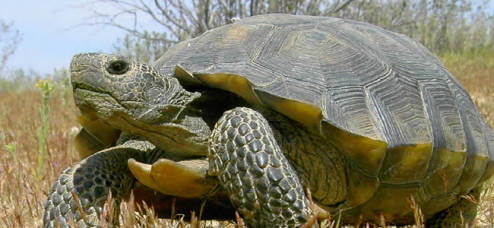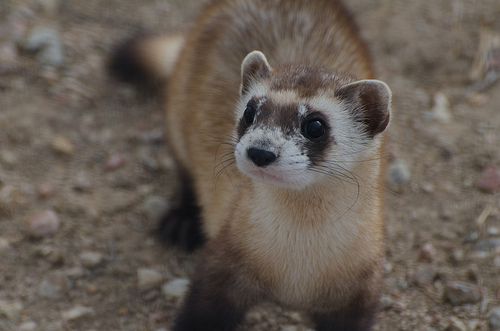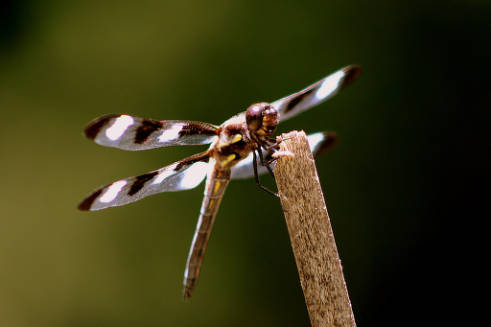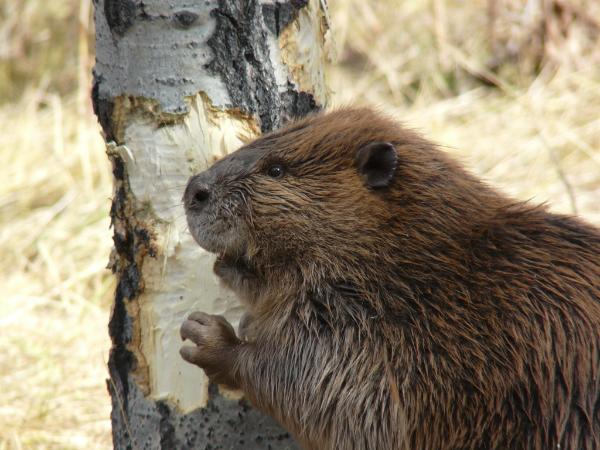A simple solution prevents hawks from being injured on the smokestacks that flare methane at landfills.
Monthly Archives: May 2013
New Tech: Ground Penetrating Radar
Texas researchers used ground penetrating radar to study pocket gophers. The researchers were able to map the pocket gopher’s tunnels to a depth of over a foot. They were also able to spot animals within the tunnels and differentiate between and underground pipeline and the pocket gopher tunnels. They wrote about it in a paper in the peer-reviewed journal Wildlife Society Bulletin.
While pocket gophers are a nuisance in places like Washington State, the subspecies studied is a species of concern for the US Fish and Wildlife Service. The research took place on a naval base.
The researchers feel that ground penetrating radar can be helpful in other wildlife management applications.
Read the Wildlife Society Bulletin paper, here. (Fee or subscription required for full text.)
No Releases for Desert Tortoises
 For decades, captive tortoises have suffered from a mysterious ailment known as “upper respiratory tract disease.” The disease was known in captive tortoises in Europe and the United States, according to information from the California Turtle and Tortoise Club.
For decades, captive tortoises have suffered from a mysterious ailment known as “upper respiratory tract disease.” The disease was known in captive tortoises in Europe and the United States, according to information from the California Turtle and Tortoise Club.
Then, in the 1980s wild desert tortoises in California suffered a major die-off from the disease.
The threat of spreading that disease to wild tortoise populations in Arizona is one of the many reasons why the Arizona Game and Fish Department does not allow the release into the wild of tortoises that have been handled for any length of time. The department cares for as many of the tortoises as it can, and also runs an adopt-a-tortoise program.
Last year the department cared for over 40 tortoises at one time.
“I can’t stress enough how detrimental it could be for both the captive and wild tortoises to release a captive tortoise in the wild,” Zen Mocarski, a department public information officer said in an AZGFD newsletter. “Along with potential disease issues and displacement, captive tortoises are not prepared to find food and water in an unfamiliar area and often die.”
Read the AZGFD newsletter item, here. (It is the third story from the bottom.)
Read the California Turtle and Tortoise Club’s upper respiratory tract disease fact sheet, here.
Photo: This desert tortoise is in Nevada. Courtesy US Fish and Wildlife Service.
Montana Takes Over USGS Gauges
Montana Fish, Wildlife and Parks needs river gauges to determine fishing (and boating) conditions, so when the US Geological Survey said it was going to stop maintaining four of the state’s river gauges because of the sequester’s funding cuts, the state said it would keep the gauges going.
According to an Associated Press story that ran in the Flathead Beacon, the USGS says it saves about $16,000 a year for each gauge it shuts down. USGS staff visit each gauge about ten times a year to make adjustments for silt build up, channel changes, debris and other river events.
That article and other in the Billings Gazette and Ravalli Republic don’t make clear whether state personnel will take over maintaining the gauges or some other arrangement has been made. It does seem clear, however, that the arrangement will last until September.
Montana’s Department of Natural Resources is also contributing to keep the gauges operational, the Flathead Beacon article says.
Read the whole story in the Flathead Beacon, here.
Read the Billings Gazette article here.
Read the Ravalli Republic article here.
Who Should Oversee Deer Breeding and Captive Hunts?
 The deer breeding and captive hunt industry would like state departments of agriculture to regulate their industry, rather than state fish and wildlife departments. The industry has made a legislative push throughout the country for more favorable regulations.
The deer breeding and captive hunt industry would like state departments of agriculture to regulate their industry, rather than state fish and wildlife departments. The industry has made a legislative push throughout the country for more favorable regulations.
A blog in Outdoor Life points out that state wildlife agencies should regulate all of a state’s deer because of the threat of disease — particularly chronic wasting disease (CWD), which is often associated with captive deer hunting facilities, and odd genes escaping into the wild deer herd, not to mention the problem of turning a public resources (wild deer) into private property.
Read the Outdoor Life blog here.
The Associated Press recently ran a story about the controversy over regulating private deer enclosures in Mississippi. The state wildlife department has regulated the facilities since 2008. A legislative committee says it shouldn’t.
Wildlife Professional magazine had an excellent article on this subject back in December. It reviews all the threats to the wild deer herd from captive hunt and deer breeding facilities.
Photo: A wild buck, by Joe Kosack/Pennsylvania Game Commission
Revised Plan for Ferrets
 “The most feasible action that would benefit black-footed ferret recovery is to improve prairie dog conservation,” said Pete Gober, black-footed ferret recovery coordinator for the US Fish and Wildlife Service in a service press release. “If efforts are undertaken to more proactively manage existing prairie dog habitat for ferret recovery, all other threats to the species will be substantially less difficult to address. Down listing of the black-footed ferret could be accomplished in approximately 10 years if conservation actions continue at existing reintroduction sites and if additional reintroduction sites are established.”
“The most feasible action that would benefit black-footed ferret recovery is to improve prairie dog conservation,” said Pete Gober, black-footed ferret recovery coordinator for the US Fish and Wildlife Service in a service press release. “If efforts are undertaken to more proactively manage existing prairie dog habitat for ferret recovery, all other threats to the species will be substantially less difficult to address. Down listing of the black-footed ferret could be accomplished in approximately 10 years if conservation actions continue at existing reintroduction sites and if additional reintroduction sites are established.”
The press release announced a draft of a revised recovery plan for the black-footed ferret.
You can read the USFWS press release here.
The Arizona Game and Fish Department release is here, in a newsletter. It’s the second article from the bottom.
Arizona has been a site of black-footed ferret recovery. Read a reporter’s first-hand account of an annual survey, here.More info on black-footed ferret recovery can be found here.
Photo: Black-footed Ferret. Credit: Kimberly Tamkun / USFWS
Revised Plan for Ferrets
 “The most feasible action that would benefit black-footed ferret recovery is to improve prairie dog conservation,” said Pete Gober, black-footed ferret recovery coordinator for the US Fish and Wildlife Service in a service press release. “If efforts are undertaken to more proactively manage existing prairie dog habitat for ferret recovery, all other threats to the species will be substantially less difficult to address. Down listing of the black-footed ferret could be accomplished in approximately 10 years if conservation actions continue at existing reintroduction sites and if additional reintroduction sites are established.”
“The most feasible action that would benefit black-footed ferret recovery is to improve prairie dog conservation,” said Pete Gober, black-footed ferret recovery coordinator for the US Fish and Wildlife Service in a service press release. “If efforts are undertaken to more proactively manage existing prairie dog habitat for ferret recovery, all other threats to the species will be substantially less difficult to address. Down listing of the black-footed ferret could be accomplished in approximately 10 years if conservation actions continue at existing reintroduction sites and if additional reintroduction sites are established.”
The press release announced a draft of a revised recovery plan for the black-footed ferret.
You can read the USFWS press release here.
The Arizona Game and Fish Department release is here, in a newsletter. It’s the second article from the bottom.
Arizona has been a site of black-footed ferret recovery. Read a reporter’s first-hand account of an annual survey, here.More info on black-footed ferret recovery can be found here.
Photo: Black-footed Ferret. Credit: Kimberly Tamkun / USFWS
Insecticide in Surface Waters
 The news is not that imidacloprid is toxic to dragonflies and snails. The chemical is an insecticide after all. No, the surprise in the paper published in PLoS ONE is how much of the stuff was found in surface water. It was enough to kill off 70 percent of the invertebrate species in some places, including mayflies, midges and molluscs.
The news is not that imidacloprid is toxic to dragonflies and snails. The chemical is an insecticide after all. No, the surprise in the paper published in PLoS ONE is how much of the stuff was found in surface water. It was enough to kill off 70 percent of the invertebrate species in some places, including mayflies, midges and molluscs.
The Guardian had the story.
Further, the loss of those species might be affecting birds that are aerial foragers, which have been in decline in North America [PDF]. (Well, the molluscs aren’t feeding aerial foragers, but they are the most endangered taxa in North America anyway.)
The study took place in the Netherlands, but if anything imidacloprid use is more widespread here. Food for thought if you are concerned with mysterious declines in dragonflies, molluscs or aerial foragers.
The point of the study was actually to research honeybee decline. Imidacloprid is a neonicotinoid.
Read The Guardian story here.
Read the PLoS ONE story here. (It’s open access, of course.)
Photo: Twelve-spotted skimmer by Rick L. Hansen, courtesy US Fish and Wildlife Service
More Beaver Benefits
 When wolves were restored to Yellowstone National Park, its riparian habitats bounced back. But it takes more than wolves killing elk to restore these habitats, a recent paper in the Proceedings of the Royal Society B: Biological Sciences says. Healthy riparian systems need beavers to create mudflats were willows can sprout and create the trademark stream-side habitats.
When wolves were restored to Yellowstone National Park, its riparian habitats bounced back. But it takes more than wolves killing elk to restore these habitats, a recent paper in the Proceedings of the Royal Society B: Biological Sciences says. Healthy riparian systems need beavers to create mudflats were willows can sprout and create the trademark stream-side habitats.
Of course, in the case of Yellowstone, the elk ate all the willows depriving the beavers of their favorite food, resulting in fewer beavers. The beavers can’t come back until the willows are big enough to eat. At the willows can’t come back until the beavers create some dams.
An article in ScienceNow calls it a chicken-and-egg problem. Certainly the study’s human-built fences and dams provide an option when the recovery area is small.
Read more in the Proceedings of the Royal Society B: Biological Sciences paper, here. (Fee or subscription required.)
Or read the ScienceNow article, here.
If you had any doubts that beaver dams add biodiversity to streams, a Freshwater Biology paper recently published online has more data for you. The study focused on a cold-water stream with native brook trout in Massachusetts. It found the dams altered the stream habitat four ways.
And if you are thinking that the beaver dams slowed the stream flow, allowing the water to warm making a habitat for warm-water species, you would be right. But the study found that it also improved conditions immediately for cold-loving native fish.
Read the paper in Freshwater Biology. (Fee or subscription required.)
Learn more about the stream in the paper, here.
Photo: Beaver in Colorado by Dennis Garrison, used courtesy of US Forest Service
